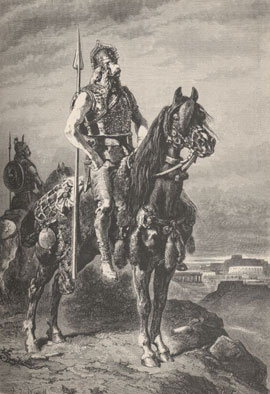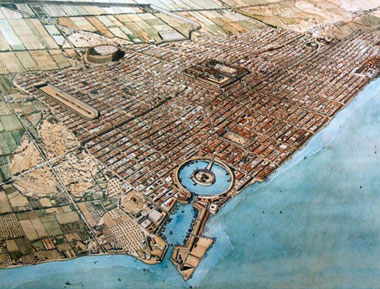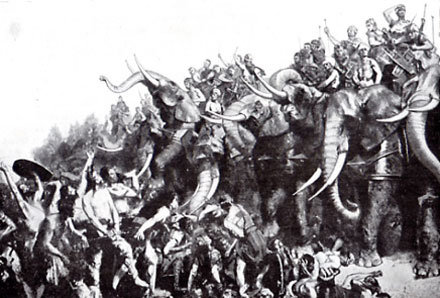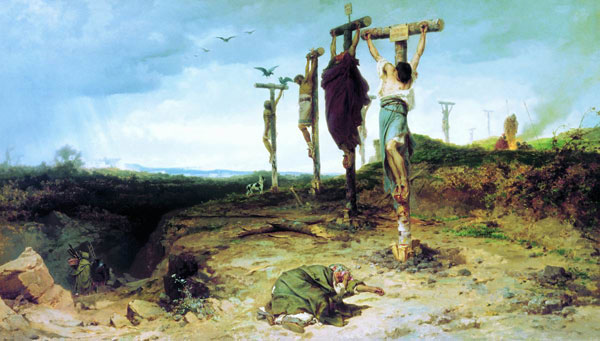The Truceless War
The Rebellion of Carthage's Mercenaries
Carthage had fought hard for 23 years against Rome and, exhausted, finally sued for peace in 241 BC. Sicily was surrendered to the Romans and the Punic troops stationed there, who had resisted for so long through fierce battles and exhausting sieges, were withdrawn. The renowned general Hamilcar Barca was removed from his post and replaced with the Carthaginian Gisco, who was to organise the evacuation and pay of the mercenaries. For, unlike the Roman army, the Punic army consisted of few genuine citizens, being composed instead of as many warriors from numerous warlike tribes as the recruiters of the rich city were able to enlist. The mercenaries slowly began arriving in Carthage by ship, expecting to receive their
promised rewards for their many years of service. Among them were heavily armed Libyan
infantry, Numidian and Mauretanian light cavalry, barbaric Celts, light-armed Iberians,
armoured Greeks and Campanians, Ligurian and Balearic slingers. There were also Roman
deserters, Lybo-Phoenicians, Half-Hellenes, half-breeds and outcasts from all the Punic
and Greek cities in Sicily and North Africa. These mercenaries did not form a coherent
army, but rather resembled a horde of nomads on the move. Many were accompanied by their
women and children or slaves. Some carried only a few personal belongings, others dragged
on pack horses, donkeys or even carts the booty of years of conquest. After 23 years of
war, many of the surviving veterans were now old men and some of their sons, born in the
camps and on the march, filled the ranks. Originally they had worn the traditional
costumes and weapons of their people and tribes, but over the course of the long war
their weapons had been replaced with better Roman equipment and the tattered clothes with
whatever could be looted or found in the markets of Sicily. All the languages of the
known world could be heard among them; the Africans were probably able to communicate in
rudimentary Phoenician, whereas others knew some Greek. Nonetheless, there were many who
depended on interpreters or on their hands.
The mercenaries slowly began arriving in Carthage by ship, expecting to receive their
promised rewards for their many years of service. Among them were heavily armed Libyan
infantry, Numidian and Mauretanian light cavalry, barbaric Celts, light-armed Iberians,
armoured Greeks and Campanians, Ligurian and Balearic slingers. There were also Roman
deserters, Lybo-Phoenicians, Half-Hellenes, half-breeds and outcasts from all the Punic
and Greek cities in Sicily and North Africa. These mercenaries did not form a coherent
army, but rather resembled a horde of nomads on the move. Many were accompanied by their
women and children or slaves. Some carried only a few personal belongings, others dragged
on pack horses, donkeys or even carts the booty of years of conquest. After 23 years of
war, many of the surviving veterans were now old men and some of their sons, born in the
camps and on the march, filled the ranks. Originally they had worn the traditional
costumes and weapons of their people and tribes, but over the course of the long war
their weapons had been replaced with better Roman equipment and the tattered clothes with
whatever could be looted or found in the markets of Sicily. All the languages of the
known world could be heard among them; the Africans were probably able to communicate in
rudimentary Phoenician, whereas others knew some Greek. Nonetheless, there were many who
depended on interpreters or on their hands.
It was a colourful and savage bunch, then, which gathered at Carthage. None of them was in the habit of paying for what he needed and weapons were always close to hand. In order to control this potentially explosive crowd the Carthaginians paid each mercenary a piece of gold and persuaded them to move to the nearby city of Sicca, south-west of Carthage, to wait for their wages. After the long years of war the Republic was having problems collecting the large sums needed and indeed may have been reluctant to pay out. Instead, Hanno the Great was commissioned to negotiate with the mercenaries to try to convince them to waive a portion of their pay. However, during the fighting in Sicily the mercenaries had been repeatedly promised rewards by Hamilcar to encourage them to endure their hardships; afterwards they had been highly impressed by the immense riches of Carthage, and now during the quiet weeks in Sicca they had plenty of time to calculate their claims over and over.
As a result, when Hanno described to them the penury of the Republic, a storm of indignation went through the camp. The veterans showed their scars and the women raised their children whose fathers remained somewhere in Sicily. Everyone recalled the hunger and cold and cruel battles. For the mercenaries it was as if they were being mocked by these smug, rich merchants trying to bargain with them over their shed blood. Furthermore, Hanno proved to be the wrong person for such negotiations. A stereotypical Carthaginian noble whose experience as a military commander had been acquired mainly quelling uprisings in Libya, he infuriated the assembled mass even more with his arrogance. The negotiations quickly broke down and the mercenaries marched towards Carthage and seized the nearby town of Tunis to enforce their demands. The Carthaginians relented, sending food and promising to pay everything. But meanwhile the demands of the mercenaries had grown. They now claimed compensation for lost horses, payment for rations they had been promised but had never received - calculated, of course, with the highest grain prices during the war - and the women insisted on the pay due to their fallen men.
The settlement of the dispute was entrusted once again to Gisco, who was popular with the troops and who appeared with a large sum of gold in Tunis. But some men tried to antagonise the situation even further. Two among them stood out: the Campanian Spendius and the Libyan Mathos. The Roman historian Polybius describes Spendius as a runaway slave but most likely he was a Roman deserter who feared extradition. In Sicily combatants from all parties deserted and switched sides, although Polybius concealed this fact in his writings as much as possible for the Romans.
Mathos had different motivations. As a Libyan he knew and feared the Carthaginians, who mercilessly squeezed the Libyan hinterland with new taxes and tributes, and cruelly suppressed the infrequent uprisings there. It became apparent that the Libyans would be paid last, and many of them wondered quite reasonably what would happen to the Libyan fighters once their comrades from other countries had been paid and had returned to their respective lands. So Mathos fuelled the old fears and hatred in the Libyans, while Spendius, who distinguished himself with his eloquence and talent for languages, agitated the other ethnic groups. Soon the whole camp was in uproar and those who recommended negotiations were stoned to death by the enraged crowd.
The rebels took Gisco prisoner along with his delegation and sent messengers to the Libyan cities asking them to join the uprising. There the hatred of Carthage was so great that all of them, except for Utica and Hippo Diarrhytos (Bizerta), sent money and reinforcements. The rebels made Mathos, Spendius and Autarit, the leader of the Celts, their commanders. They then divided their forces into three armies, two of which lay siege to Utica and Hippo Diarrhytos, while the third remained in the camp at Tunis.
 Meanwhile, Carthage mobilised its reserves. The ships of the fleet were repaired, new
mercenaries recruited and the citizens armed. Finally Hanno was able to set off to the
relief of Utica with a strong army including about 100 elephants and numerous war
machines. With his elephants, he managed to successfully storm and rout the enemy camp.
While his army plundered the conquered camp, Hanno went to Utica, to celebrate his
victory with an enormous feast. But the mercenaries were not the simple country folk
against whom he normally fought, they were experienced and battle-hardened veterans.
After re-grouping on a hill they made a new counter-attack in which they conquered the
Punic camp and killed numerous enemies and elephants.
Meanwhile, Carthage mobilised its reserves. The ships of the fleet were repaired, new
mercenaries recruited and the citizens armed. Finally Hanno was able to set off to the
relief of Utica with a strong army including about 100 elephants and numerous war
machines. With his elephants, he managed to successfully storm and rout the enemy camp.
While his army plundered the conquered camp, Hanno went to Utica, to celebrate his
victory with an enormous feast. But the mercenaries were not the simple country folk
against whom he normally fought, they were experienced and battle-hardened veterans.
After re-grouping on a hill they made a new counter-attack in which they conquered the
Punic camp and killed numerous enemies and elephants.
After this disaster the Carthaginian Senate finally decided to put the disgraced general Hamilcar Barca in command of a new army. Although Hamilcar had fewer troops than Hanno, he defeated the mercenaries near Utica and rescued the city, and went on to subdue a series of other smaller towns. Apart from his outstanding qualities as a military commander, nobody knew the enemy better than he, since they had honed their skills under his command in Sicily. Almost all of them feared or admired him, and when he offered an amnesty and began enlisting prisoners without penalty in his own army, many defectors signed up, eager to serve again under their old master. To deal with this threat the leaders of the mercenaries - especially Spedios and Autarit - decided to burn their bridges and kill all of the Carthaginian prisoners, even Gisco and his delegation. Moreover it was decided to take no more prisoners from that point on, and it is said that they kept this ruthless resolution to the bitter end.
Later Roman historians, who are the only sources for these events, used this cruelty as proof that the mercenaries were a wild horde of savage barbarians who were no better than animals. However it should also be remembered that the old veterans of the Punic War, while forming the backbone of the original insurgent army, were by then a minority, and the vast majority of the remaining forces comprised the levies of Libyan cities, ruined farmers and runaway slaves. And there are many accounts of how Rome treated rebellious cities and provinces: the lucky ones were sold into slavery; often everybody and everything - old men, women, children, sometimes even the domestic animals - were mercilessly slaughtered or crucified. The Carthaginians had behaved similarly in Libya for generations; during the war in Sicily a group of 3,000 Libyan mercenaries suspected of treason was crucified en masse. While Hamilcar had initially shown unusual mercy he had, like a real condottiere, only been trying to lure the best troops into his service. The insurgent Libyans would ultimately be the ones to suffer punishment for the rebellion.
After the treacherous murder of the Carthaginian delegation, Hamilcar refused to show any kind of mercy, and ordered all prisoners to be massacred, many by crucifixion or trampled by elephants. It did little to change the situation. Due to mutual jealousies and intrigues, Hamilcar and Hanno were incapable of working jointly. The intensified exploitation of the Libyan cities by the Carthaginians even provoked the until-then faithful cities Utica and Hippo Diarrhytos to slaughter the Carthaginian garrisons and to open their gates to the insurgents. So reinforced the rebels began to besiege Carthage itself. But without heavy siege equipment they had no chance of successfully storming the gigantic walls. Fortunately for Carthage, Rome and Syracuse eventually came to the conclusion that a successful rebellion in Libya would undermine their own authority, and they began to support her former rival forcefully. They provided food and weapons - Syracuse even sent mercenaries - and prohibited trade with the rebellious cities. In Carthage, the Senate finally decided to replace Hanno with Hannibal, who co-operated better with Hamilcar. Together they managed to cut the besiegers off from the hinterland, forcing them to abandon the siege at last.
The rebels now divided their forces. While the larger part remained under Mathos with the supply train in Tunis, 50,000 of the best troops, among them most of the surviving mercenaries, moved under the command of Spendius and Autarit into the Atlas Mountains. Because Hamilcar was superior in cavalry and above all had the advantage of his elephants, they hoped to use the rough terrain for a decisive battle in their favour. But during the subsequent tactical manoeuvres Hamilcar once again demonstrated his superiority as a commander. He succeeded in luring the rebels into a deep ravine known as "The Saw", because of the rugged mountains surrounding it, where they were trapped and cut off from supply routes. After all attempts to force their way out had failed, they waited for relief from Tunis. But as they waited in vain their hunger grew ever worse, and they slaughtered first their prisoners and then their slaves.

When they had finally lost all hope, they sent ten of their leaders to Hamilcar to negotiate their surrender. They proposed that he select any ten rebels for punishment and let the others go, leaving behind their weapons. Hamilcar took the ten leaders themselves before attacking the desperate insurgents. It was a horrific massacre. Weakened by hunger, with no way of escape, deprived of their leaders and in total disarray they offered little resistance. Hamilcar spared no one; even those who surrendered unconditionally were trampled by his elephants. It is said that more than 40,000 of them perished there.
After this victory, Hamilcar and Hannibal went to Tunis to defeat Mathos and the remaining rebel troops. They set up two fortified camps on opposite sides of the city and began the siege. To remind the rebels of their impending fate, Hannibal had the ten captured leaders tortured and crucified outside the city walls. And so died the Campanian Spendius and Autarit the Celt. Encouraged by this cruel demonstration, the Carthaginians began to celebrate their forthcoming victory. But Mathos still possessed a small core of proven veterans. When he noticed the Carthaginians' guard was down, he made a surprise sortie and took Hannibal's camp. Many Carthaginians were slain, and Hannibal and some of his officers were taken prisoner. The mercenaries then took the dead Spendius down from the cross and nailed Hannibal in his place. Above Spendius's prone body they crucified 30 noble Carthaginians as a blood sacrifice for their fallen commander
Now the forces were balanced again and both armies roved around the hinterland of Carthage, besieging cities and fighting smaller battles. The war dragged on until finally both parties were exhausted. Countless men had been killed and all had been pushed to the utmost limit of their capacity to suffer or even beyond. The two sides agreed on a final and decisive battle. The Carthaginians armed all their citizens, and the Libyans mustered all contingents of the rebellious cities. There weren't many surviving mercenaries, mainly some Gauls and Greeks, who together with the Libyan veterans formed a phalanx. But the bulk of the rebel army consisted of desperate citizens, poorly armed farmers and former slaves. The battle was fought with desperation, neither side expecting mercy. When the Libyans succumbed in the end there were very few survivors, but among them was Mathos. He was dragged with the other prisoners in a triumphal procession through Carthage and then tortured to death by the youth of the city.

Thus ended the Truceless War, as it is sometimes called. Polybius, who lived in a time of abundant destruction and bloodshed, remarked that this war "excelled all wars we know of in cruelty and defiance of principle. " But the history of mercenaries in the service of Carthage didn't end with the war. Almost exactly twenty years later Hamilcar's son Hannibal led an army of Iberians, Libyans, Numidians, Mauretanians, Celts and others over the Alps. His elite were his "old Africans" - the Libyan infantry.